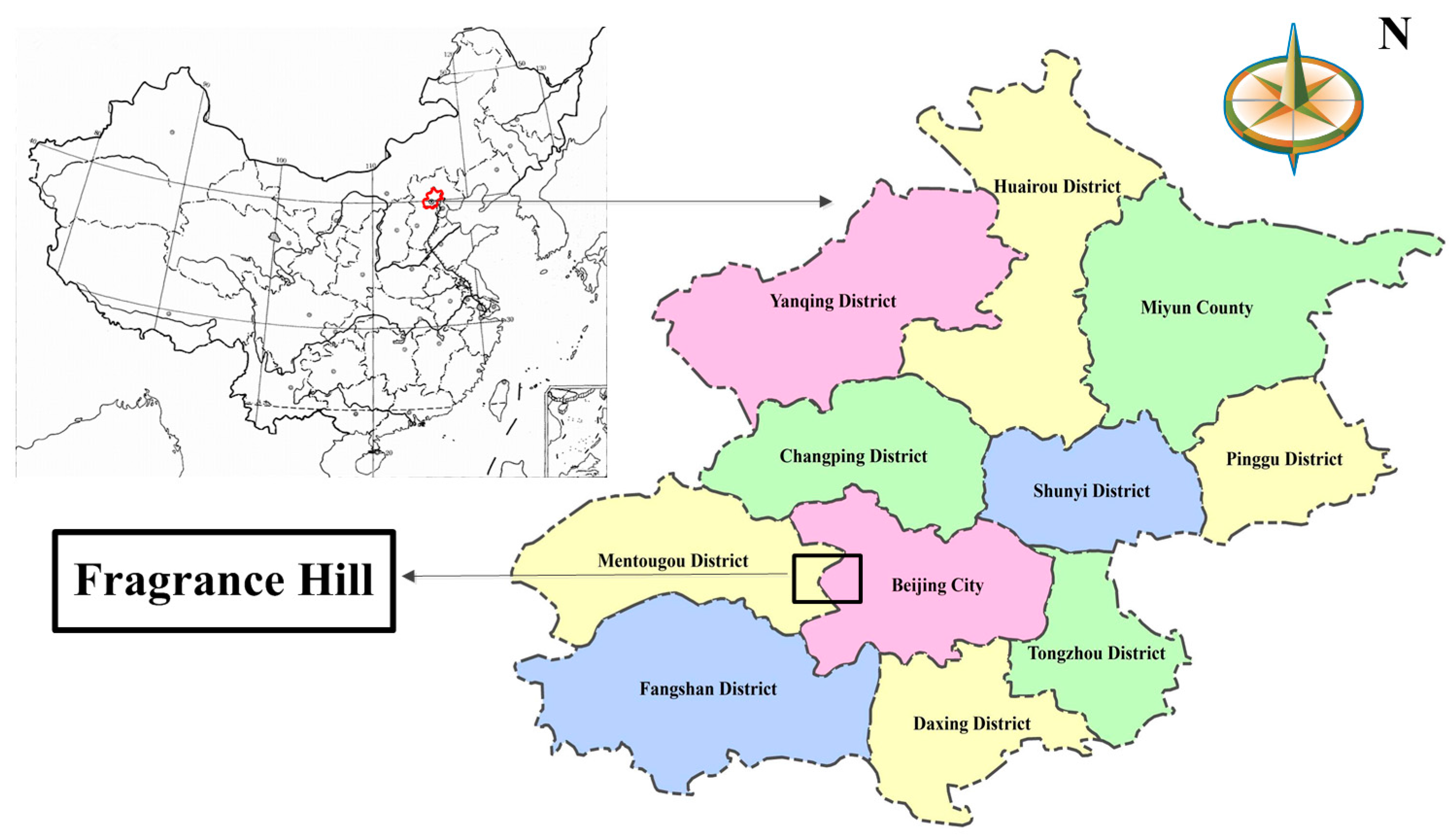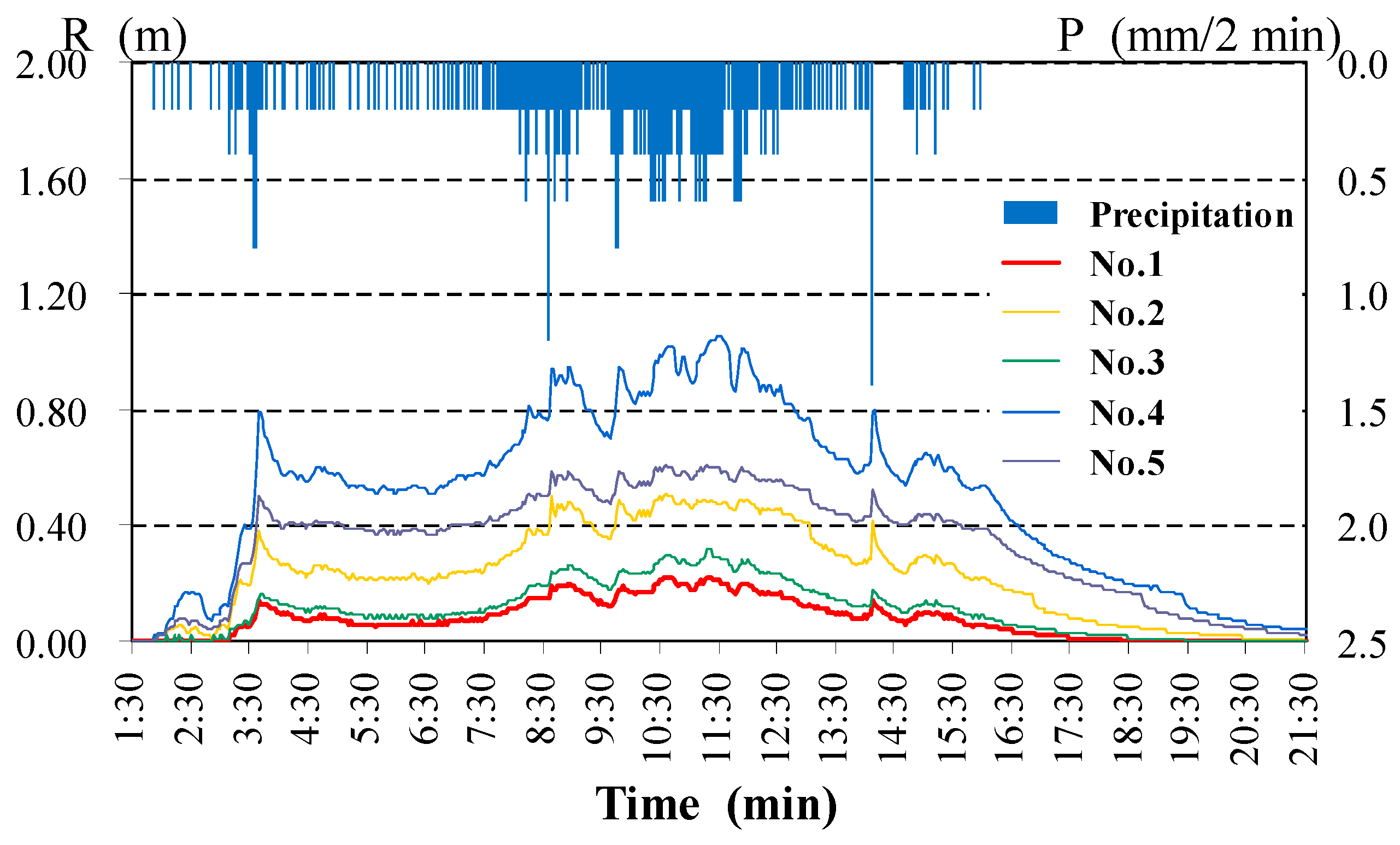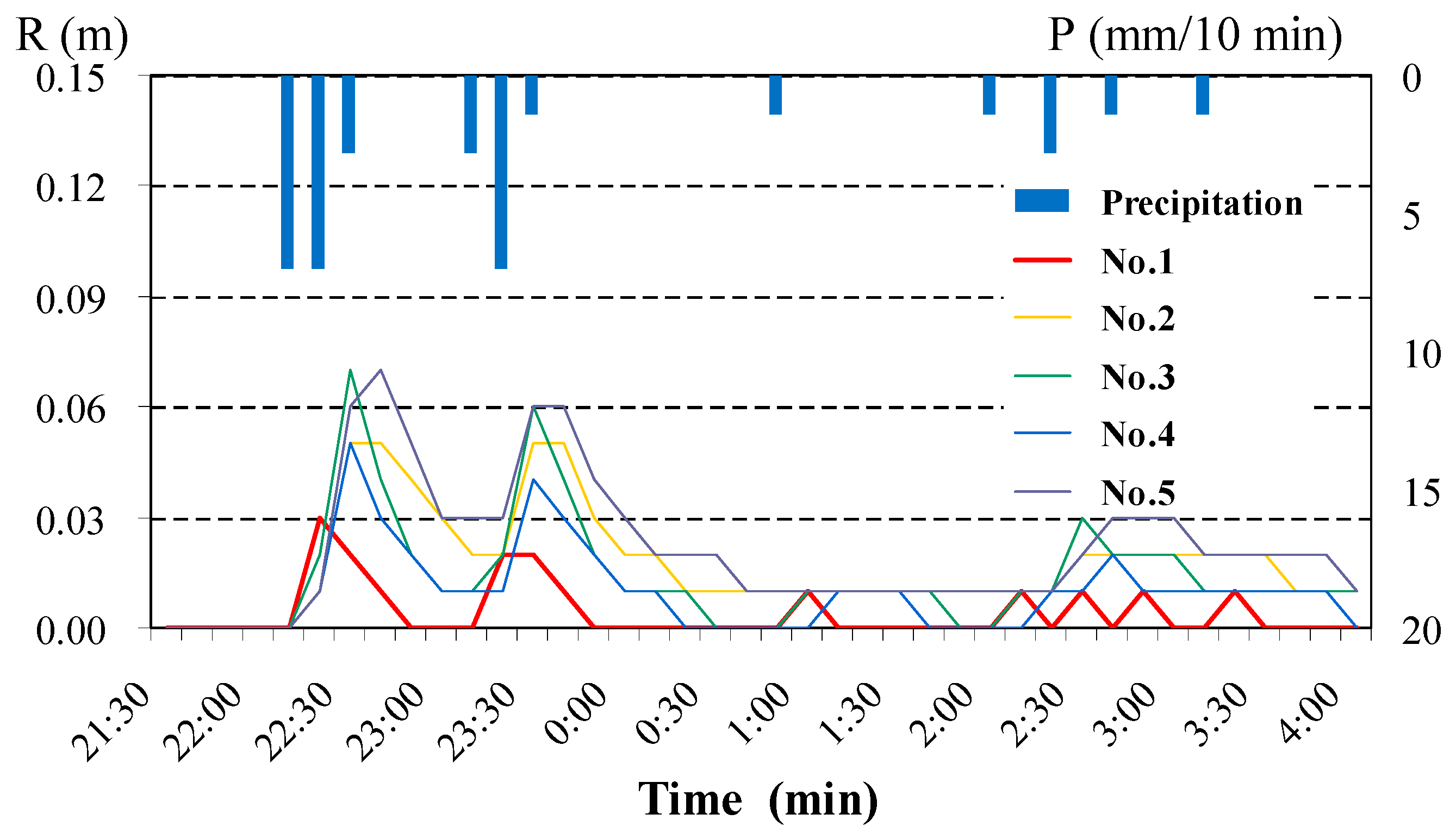4.2. Runoff Volume Reduction
The percentages of runoff reduction in different LID scenarios were calculated and analyzed for evaluating their runoff reduction effectiveness (
Table 8). Among all of the single measures, concave greenbelt is the most effective in runoff reduction, especially when the return period of precipitation is shorter than two years. The runoff reduction percentages of concave greenbelt ranged from approximately 5.2% to 57.3% in all types of rainfall events and the reduction percentages are much higher (20.5–57.3%) in the one-year and two-year rainfall events. It is notable that when the concave ratio is 50%, the total runoff can be reduced to 52.5% for the one-year rainfall event, proving the high effectiveness of concave greenbelts in flood mitigation. By contrast, when the concave ratio was 70% or 90%, the reduction percentage increased slightly in comparison with that of the 50% ratio, within a range of 1.5–5.0% in different types of rainfall. That is, the concave ratio of 50% is better for stormwater detention. Therefore, there is no need to expand the facility scale.
Vegetative swale is the least significant among all the single measures, and its entire runoff reduction percentages at the “O1” outlet are only 0.3–3.0%. There are two reasons for this: the first reason is the limits of the application area and frequency in mountain areas (only five lengths of one road applied this measure in the whole region); the other reason is the fast flooding of mountain floods. These results indicated that the vegetative swale is not suitable in mountains areas, although it is effective in controlling runoff in plain areas [
49,
50,
51].
In the permeable pavement scenario, the runoff reduction percentage of S38 ranged from 7.3% to 12.2% in the one-year rainfall event and from 1.9% to 7.0% in the ten-year rainfall event when the permeable pavement ratio of the roads ranged from 50% to 70% (
Table 8). This result indicated 70% permeable pavement is much more effective than 50% permeable pavement when it was applied in the roads of a typical residential community.
In the bio-retention measure scenario,
Table 8 illustrated that the total runoff of S69 was reduced significantly to 10.2–12.1%. It is remarkable that when the return period of rainfall increased, the decrease trend of runoff reduction percentage was smoother than that in the other scenarios, which implies that this measure has a better reduction effectiveness in various rainfall intensities.
In the comprehensive measures scenario, the percentages of runoff reduction ranged from 15.4% to 57.3% The results compared with the other scenarios demonstrated that the reduction effectiveness (57.3%, the maximum one) is equal to that of 90% concave greenbelt in the one-year rainfall event and the comprehensive utilization of various measures can further improve the effectiveness in the other rainfall events. It is notable that the effectiveness in the comprehensive measures scenario is not equivalent to the summation of each single measure. A possible reason for this phenomenon is that applying various measures changes the state and process of the runoff in part of the study area, which likely offsets some of the overall effectiveness. As a result, the comprehensive utilization of various measures is less effective than the total effectiveness of various measures.
Overall, all the above LID measures can reduce the runoff volume to a certain magnitude in the rainfall events with the return periods shorter than five years and they are less effective in the precipitation events in the return periods longer than five years. The concave greenbelt and comprehensive measures were more effective, while the vegetative swale was the least effective measure. Permeable pavement can have a certain effect in typical sub-catchment and the bio-retention has better reduction effectiveness for a variety of rainfall intensities in the typical catchment. The effectiveness of runoff reduction in all of the scenarios decreased as the rainfall intensity increased.
4.4. Traffic Congestion Relief
The ponding situation of “O1” is paramount to relieve the traffic congestion on the Xiangquan Roundabout during storms, due to the station of O1 outfall (
Figure 4). Therefore, the duration and depth of ponding were both involved in this section. The critical value of the ponding depth was assigned as 15 cm for the drainage design of municipal roads, considering the limit of the ponding height for the vehicles. Thus, the durations of ponding depth over 15 cm at O1 in different LID scenarios and the basic scenario were calculated (
Table 10) and can reflect different traffic situations on the Xiangquan Roundabout.
Table 10 and
Figure 8 illustrate that the frequency of traffic congestion resulting from flooding is seldom in the one-year event in all the scenarios; the situation of traffic congestion becomes more severe with the growing of the rainfall return periods. The shortening percentage in different LID scenarios (
Table 11) were calculated based on the duration in basic scenario, for the convenience of evaluation and comparison.
Table 10 and
Table 11 indicate that the concave greenbelt and comprehensive measures are both effective in relieving the traffic congestion in all of the rainfall events, and the least percentage is 29.1%. In the two-year rainfall event, the corresponding effectiveness for both scenarios was significant. These two durations of ponding depth over 15 cm are 48 min and 30 min, respectively (both less than one hour), and the corresponding shortening percentage is 51.0% and 69.4%, respectively. The result indicated only by these percentages is concordant with evaluation results in the other aspects.
However, the vegetative swale played less of a role in relieving traffic congestion in all of the rainfall events. Its largest shortening duration is only 2 min in the two-year event, and it is ineffective in the ten-year event. The ineffectiveness of applying vegetative swale in traffic congestion relief is inevitable when this measure showed its ineffectiveness both in runoff volume reduction and perk discharge reduction.
Table 10 and
Table 11 also indicate that the effectiveness in traffic congestion relief worsened when the return periods of rainfall increased, and this decline trend is similar to those in the other aspects (
Table 8 and
Table 9). In addition, the comprehensive measures, as the most effective LID measures in this aspect, decreased most sharply when the return periods increased. Its shortening percentage decreased from 69.4% to 34.0%.
However, all of the durations of over 15 cm are more than one hour in the five-year and ten-year rainfall events. This means that traffic congestion would also exist in these rainfall events in the Xiangquan Roundabout if these LID measures are constructed.
Table 10 indicates that the duration over 15 cm is approximately 50 min in two-year event, if the concave greenbelt is applied. This means that the traffic congestion would also be serious in the two-year event, although the related reduction percentages is high, which is different from the evaluation of the other methods.
Because Xiangquan Roundabout is located in the low-lying region of the FHC and its pipeline infrastructure is deficient, LID measures have less of an effect when the precipitation intensity is large; and even if LIDs could have a greater effect, they would only be effective in the storage of the local storm, while the flood from the upper reaches and interval region can also remarkably result in the waterlogging of this transportation hub. However, the substantial controlling measures for the mountain flood should combine water conservancy projects and drainage pipeline networks, and only LID measures are less effective. This analysis would supply the different decision-making for the local government.
In summary, only the implementation of LID measures was far from ideal for solving the interval problems of both flood and waterlogging on the mountainous areas. The analysis agrees with the results of the other relevant research [
52]. For the mountainous areas, rational analysis and decision-making in accordance with the regional characteristics and the above-described results are required before the implementation of stormwater management, flood management and SPC. In this study, the critical goal of regional waterlogging control is to guarantee the normal operation of transportation hubs of the Xiangquan Roundabout and relieving the traffic congestion. Accordingly, the construction of drainage pipe networks in the downstream low-lying areas should be first considered in making SPC schemes, i.e., the condition of the flood pouring down the street should be avoided. If well-funded, some retaining facilities such as flood-cutting channels should be built in upstream areas. Meanwhile, the drainage network should be expanded and the drainage canals should be dredged on both sides of the roads in middle-reach areas. Moreover, the LID measures coupled with underground tunnels should be built in downstream areas. Only when the runoff during the entire process was controlled, the dilemma of Xiangquan Roundabout being frequently flooded after storms would be fundamentally improved.
In addition, effective non-engineering measures should be employed in the FHC. A regional water-logging risk map should be developed and announced according to the simulation results of the ponding depth under different storm scenarios. The awareness of risk evasion should be acknowledged and build up to the public, especially the inhabitants in the low-lying areas (also the high-risk areas). Meanwhile, the corresponding countermeasures for different levels of ponding risk should be formulated. Although the risk map is static, it should be the crucial reference to the local regulation and planning for the future urban development and construction. Based on this static map, the regional real-time water-logging warning would be achieved combining the dynamic rainfall forecasting through satellite and radar. Furthermore, due to the importance of Xiangquan Roundabout for local transportation, a regional risk map for traffic jam and the corresponding countermeasures for various traffic jam risks should also be formulated according to the suggested traffic alleviation measures in this paper. In this way, the real-time warning of traffic congestion would be achieved, based on the risk map for traffic congestion and the dynamic warning of water-logging risk. If the congestion risk was high, the public would be notified in advance. Thus, the residents could optimize the traffic routes and avoid driving in the high-risk area. Vehicles and people that have entered the high risk area should be guided to the safe spots in accordance with the established evacuation routes, in order to minimize the property losses and lower the risk of traffic congestion.
In the future, field experiments and effect analysis on different LID measures should be carried out based on the related research results and can be convenient for comparing the effectiveness of the model simulation compared with practical engineering. The related results would supply more significant reference for decision-making, to further improve future stormwater and flood management. Additionally, the expected economic benefits of employing LID measures would be analyzed and discussed. These two aspects should be investigated in the future to propose reasonable construction scales of LID measures and then optimize regional the SPC scheme.
This study applied the data and information of detailed investigations, surveys and interviews for model calibration and validation due to the absence of observed runoff data in the study region. In the future, the pipeline and canal flow should be observed and monitored through a triangular weir, hydrometric propeller, and Acoustic Doppler Current Profilers (ADCP) to improve the modeling accuracy.
This study evaluated the effectiveness of the LID measures in reducing the quantity of runoff. In the future, the effectiveness on controlling non-point source pollution from storms should be analyzed and discussed. The above conclusions were applicable to mountainous urban units with semi-arid climate zones. In the future, the feasibility of the LID measures in urban units of humid zones and arid zones should be evaluated.














